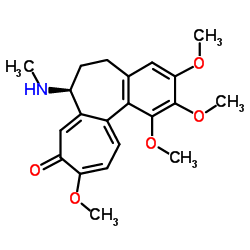(-)-Demecolcine

(-)-Demecolcine structure
|
Common Name | (-)-Demecolcine | ||
|---|---|---|---|---|
| CAS Number | 477-30-5 | Molecular Weight | 371.427 | |
| Density | 1.2±0.1 g/cm3 | Boiling Point | 625.5±55.0 °C at 760 mmHg | |
| Molecular Formula | C21H25NO5 | Melting Point | 73-75ºC | |
| MSDS | Chinese USA | Flash Point | 332.1±31.5 °C | |
| Symbol |

GHS06 |
Signal Word | Danger | |
|
Determination of colchicine and O-demethylated metabolites in decomposed skeletal tissues by microwave assisted extraction, microplate solid phase extraction and ultra-high performance liquid chromatography (MAE-MPSPE-UHPLC).
J. Chromatogr. B. Analyt. Technol. Biomed. Life Sci. 960 , 145-50, (2014) Microwave assisted extraction (MAE) followed by microplate solid phase extraction (MPSPE) coupled with ultra high performance liquid chromatography (UHPLC) for the semi-quantitative determination of colchicine, 3-demethyl colchicine and 2-demethyl colchicine ... |
|
|
High-affinity accumulation of a maytansinoid in cells via weak tubulin interaction.
PLoS ONE 10(2) , e0117523, (2015) The microtubule-targeting maytansinoids accumulate in cells and induce mitotic arrest at 250- to 1000-fold lower concentrations than those required for their association with tubulin or microtubules. To identify the mechanisms of this intracellular accumulati... |
|
|
Differentiation of primordial germ cells from induced pluripotent stem cells of primary ovarian insufficiency.
Hum. Reprod. 30(3) , 737-48, (2015) Can the induced pluripotent stem cells (iPSCs) derived from women with primary ovarian insufficiency (POI) differentiate into germ cells for potential disease modeling in vitro?The iPSC lines derived from POI patients with 46, X, del(X)(q26) or 46, X, del(X)(... |
|
|
Production of Cloned Miniature Pigs Expressing High Levels of Human Apolipoprotein(a) in Plasma.
PLoS ONE 10 , e0132155, (2015) High lipoprotein(a) [Lp(a)] levels are a major risk factor for the development of atherosclerosis. However, because apolipoprotein(a) [apo(a)], the unique component of Lp(a), is found only in primates and humans, the study of human Lp(a) has been hampered due... |
|
|
Trace levels of mitomycin C disrupt genomic integrity and lead to DNA damage response defect in long-term-cultured human embryonic stem cells.
Arch. Toxicol. 89(1) , 33-45, (2015) How to maintain the genetic integrity of cultured human embryonic stem (hES) cells is raising crucial concerns for future clinical use in regenerative medicine. Mitomycin C(MMC), a DNA damage agent, is widely used for preparation of feeder cells in many labor... |
|
|
HIPK2 deficiency causes chromosomal instability by cytokinesis failure and increases tumorigenicity.
Oncotarget 6 , 10320-34, (2015) HIPK2, a cell fate decision kinase inactivated in several human cancers, is thought to exert its oncosuppressing activity through its p53-dependent and -independent apoptotic function. However, a HIPK2 role in cell proliferation has also been described. In pa... |
|
|
Chronic Exposure to Particulate Chromate Induces Premature Centrosome Separation and Centriole Disengagement in Human Lung Cells.
Toxicol. Sci. 147 , 490-9, (2015) Particulate hexavalent chromium (Cr(VI)) is a well-established human lung carcinogen. Lung tumors are characterized by structural and numerical chromosome instability. Centrosome amplification is a phenotype commonly found in solid tumors, including lung tumo... |
|
|
A Cell Electrofusion Chip for Somatic Cells Reprogramming.
PLoS ONE 10 , e0131966, (2015) Cell fusion is a potent approach to explore the mechanisms of somatic cells reprogramming. However, previous fusion methods, such as polyethylene glycol (PEG) mediated cell fusion, are often limited by poor fusion yields. In this study, we developed a simplif... |
|
|
Generation of embryonic stem cells from mouse adipose-tissue derived cells via somatic cell nuclear transfer.
Cell Cycle 14(8) , 1282-90, (2015) Somatic cells can be reprogrammed into embryonic stem cells (ESCs) by nuclear transfer (NT-ESCs), or into induced pluripotent stem cells (iPSCs) by the "Yamanaka method." However, recent studies have indicated that mouse and human iPSCs are prone to epigeneti... |
|
|
Cell Fusion Connects Oncogenesis with Tumor Evolution.
Am. J. Pathol. 185 , 2049-60, (2015) Cell fusion likely drives tumor evolution by undermining chromosomal and DNA stability and/or by generating phenotypic diversity; however, whether a cell fusion event can initiate malignancy and direct tumor evolution is unknown. We report that a fusion event... |